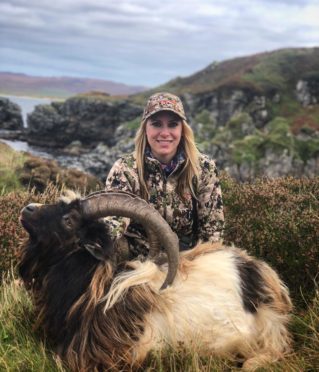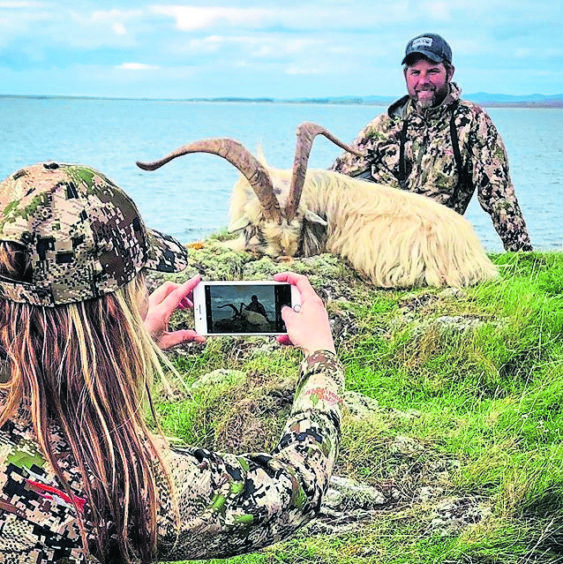An American TV star and self-styled “hardcore huntress” has been criticised by politicians and tourism chiefs for posting photos of dead “trophies” – including goats and sheep – online.
Larysa Switlyk posted a series of pictures taken on Islay with a companion called Jason, who she rewarded with a “gold medal” for shooting a goat.
While bragging about the kills, which also included a stag, the star encouraged more people to join hunting trips with the company she works for.
Last night Environment Secretary Roseanna Cunningham pledged to review the situation and consider whether changes to the law are required.
Local MSP and Cabinet Secretary Michael Russell had raised the issue with his government colleagues and said this type of hunting and the flaunting of it was “a massive deterrent to tourism”.
He said: “I have raised this with the environment secretary.
“My view of it is that for every one person that might be attracted to Islay by the prospect of shooting a goat, there will be 1,000 people who will be repelled and horrified by this.
“This is not the tourism that Scotland wants or needs and it is not the image that Scotland wants or needs.
“I acknowledge that stalking of stag takes place. It is usually for meat and culling under regulation.
“What I don’t accept is trophy hunting done for profit. I don’t accept images of people in camouflage with high power sniper rifles. It is unacceptable. It is not only wrong, in my view it is a massive deterrent to tourism.”
Ms Switlyk, who last night hadn’t responded to a request for comment, wrote on her Facebook page: “Beautiful wild goat here on the island of Islay in Scotland. Such a fun hunt!! They live on the edge of the cliffs of the island and know how to hide well.
“We hunted hard for a big one for two days and finally got on this group.
“Made a perfect 200 yard shot and dropped him… (Good thing too because he could have ran (sic) off the cliff into the water).”
A Scottish Government spokeswoman said: “We fully understand why so many people find these images of hunted animals being held up as trophies so upsetting.
“Responsible and appropriate culling of animals is a necessary part of sustainable land management and the culling of some wild animals, including deer and goats, is not illegal.
“However, we understand the concerns raised by these images and, in light of them, the Environment Secretary will review the situation and consider whether any clarification of or changes to the law might be required.”
Barbara Clark, head of corporate communications at VisitScotland said: “There is a thriving hunting and fishing sector in Scotland, but there has to be sensitivity about pictures that are posted on social media.
“We do very much urge that people think before they post images online. There are people with different views and they should be respected.”
A police spokeswoman said they were aware of the posts and the wildlife crime unit would look into the incident.
Scottish Gamekeepers Association chairman Alex Hogg said: “We don’t know the circumstances around this image but if paying visitors are coming to Scotland to do a job that would have been done anyway and are spending in local communities whilst doing so, then calling for immediate bans may be a knee-jerk reaction. Facts would need to be established.”
Celebrities Ricky Gervais, Gabby Logan and Judy Murray and Mia Farrow condemned the behaviour.
Mia Farrow tweeted: “You have a gun. The goat did not. This is not sport, it’s slaughter.”
Global trophy hunting
Every year hundreds of thousands of wild animals globally are killed solely to obtain a “prize”—that is, the heads, hides or pelts, and even whole stuffed animals—to hang on a wall, throw on the floor, or pose in a room.
Trophy hunters have killed over 78,000 mountain lions in the last two decades , according to a report, State of the Mountain Lion, released by The Humane Society of the United States.
A study calls humans “the unsustainable super predator” because it claims we kill too many wild animals, including top-level carnivores. Wolves, bears, mountain lions, and bobcats are killed annually in the U.S. solely for trophy and by killing methods including hounding, baiting and trapping.
The death of Cecil, the African lion killed by an American dentist in 2015, shed a global spotlight on the gruesome nature of trophy hunting. The public rejects trophy hunting — according to a recent nationwide poll — by a two-to-one margin.
Globally, the trophy hunting of rare animals is a booming business largely championed by the US-based Safari Club International (SCI). The SCI encourages wealthy big-game hunters to compete in contests to kill the most animals for awards, such as the “Africa Big Five” that includes lions, elephants, rhinos, leopards, and Cape buffaloes.
Americans are primary participants in the international trophy trade, with more than 3,100 “Africa Big Five” species killed and imported into the United States by trophy hunters.
Hunting in Scotland
Several tourism companies offer the chance to stalk and shoot wild goats in Islay, Dumfries and Galloway and other parts of the UK.
The animals, which have no natural predator, are classed as an invasive, non-native species in the UK, and hunting them on private land is not illegal.
Culls have been carried out in some areas to reduce their numbers, while contraceptive darts have also been used to stop the animals reproducing.
Feral goats are thought to have roamed parts of Scotland and the north of England for about 5,000 years.
There are currently estimated to be about 3,000 animals in herds spread across the country.
In Scotland people can be fined or jailed for hunting illegally or causing unnecessary suffering to an animal.
Participants must follow the rules for hunting and shooting wildlife including: what you can hunt or shoot; when you can do it; what equipment you can use.
People must have permission from the landowner. They must have a certificate to use a shotgun, rifle or other firearm.
Certificates are not required for air rifles up to 12ft lb in power and air pistols up to 6ft lb in power.
The use of bows, crossbows and explosives (other than the legal ammunition for a firearm) is prohibited.

